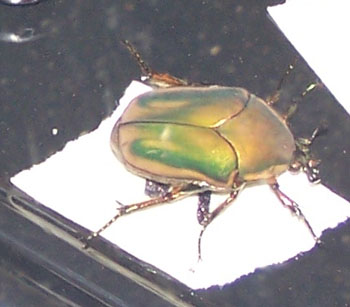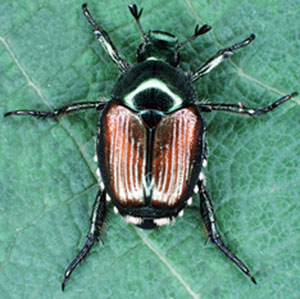Symptoms Management Life Cycle More Info
Phil Mulder, Oklahoma State University
Symptoms
Green June beetles damage clusters by feeding on ripening berries. Beetles gain entry into undamaged fruit by gouging with the horn on the front of the head, then feeding on the flesh of the fruit. Their odor and excrement may ruin fruit even if feeding damage is not severe.
The grubs of Japanese beetles feed primarily on the roots of grasses and leaves as well as flowers. Adult beetles eat the leaf tissue between the veins, so the foliage looks somewhat lace-like.
Management
Adults of both species can be effectively trapped using either a specialized trap and pheromone source for the Japanese beetle (JB) or a ripe, cut fruit trap for green June beetle (GJB). Set GJB traps adjacent to vineyards and monitor regularly for activity; however, if harvest of grapes is not delayed and fruit does not become overly ripe before being picked, then problems with this insect are minimal.
Use of traps for JB iscontroversial. Some believe that the pheromone traps lure more beetles to the area. They should be placed a minimum of 200 feet away from grapes, in order to avoid attracting the pests into the vineyard. Detecting damage is not a problem, as skeletonized leaves are obvious. In areas with high populations of JB, insecticidal control may be necessary. Infestation is often along edge rows or ends of rows, where adults emerge from grassy areas outside the vineyard and move to the first few vines to feed. Consequently, spot spraying may be adequate. Insecticides with long residual activity are needed when beetle populations are high. Repeat applications may be needed.
Life Cycle
These two species are both scarab beetles that overwinter as larvae either in pastures or in grasses. They pupate in the soil sometime in late May and emerge as adults in late June. In July and August, they lay eggs and the cycle repeats itself.
Japanese beetles have been steadily migrating west from their entry point on the east coast. They have been common in the Midwest since the early 1990s. In some years, their populations are so high that almost complete defoliation of preferred hosts is possible.
As the grape industries grow on the western boundary of Japanese beetle infected areas, they may experience more pronounced problems with this insect. The GJB is a common pest of most fruits in Midwest, feeding on sweet sap as any of these fruits begin to ripen.
Recommended Resources
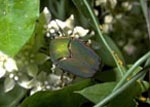 Green June Beetle, Texas A&M University
Green June Beetle, Texas A&M University
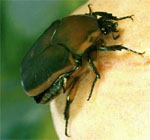 Green June Beetle, Oklahoma State University
Green June Beetle, Oklahoma State University
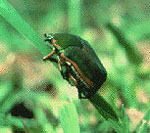 Green June Beetle, Auburn University
Green June Beetle, Auburn University
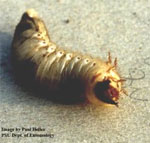 Green June Beetle, Pennsylvania State University
Green June Beetle, Pennsylvania State University
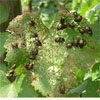 Japanese Beetles in the Urban Landscape, University of Kentucky
Japanese Beetles in the Urban Landscape, University of Kentucky
 Managing the Japanese Beetle: A Homeowner’s Handbook, USDA
Managing the Japanese Beetle: A Homeowner’s Handbook, USDA
Midwest Small Fruit Pest Management Handbook, Ohio State University
Midwest Small Fruit and Grape Spray Guide
Field Guide for Integrated Pest Management in Pacific Northwest Vineyards. Washington State University
Distinguishing between leafhopper and Japanese beetle damage video, Cornell University
Reviewed by Eric Stafne, Mississippi State University and Bruce Bordelon, Purdue University

